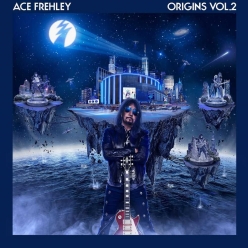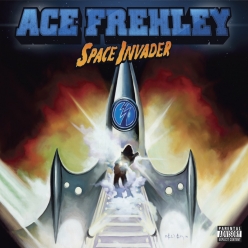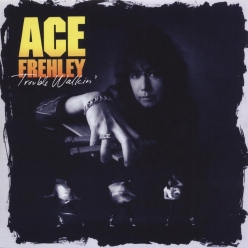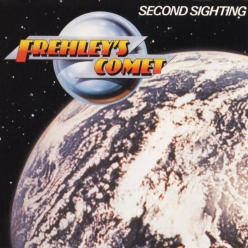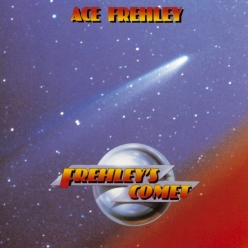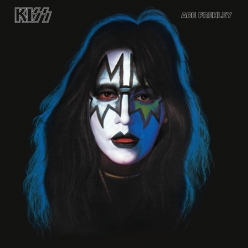Biography
Growing up on the corner of Marion Avenue and 201st Street, off Bedford Park Boulevard (a/k/a 200th Street) and Webster Avenue in the Bedford Park section of the Bronx, Frehley graduated from Grace Lutheran School at age 13. However, he was thrown out of two high schools and dropped out of the third. Two of the high schools he attended were DeWitt Clinton High School on Mosholu Parkway and Theodore Roosevelt High School on Fordham Road. He got the nickname "Ace" in high school from friends who said he was "a real ace" for his ability to get them dates. Also in his high school years, a guidance counselor encouraged him to get into graphic arts. His family did not have much money, and in his teen years, Frehley got involved in street gangs. He later credited guitar playing for "saving his life" as a member of Kiss.
Frehley's earliest bands included The Outrage, The Four Roses, King Kong, Honey and The Magic People. When Frehley's later band, Cathedral, began getting paying gigs, he dropped out of high school. At the insistence of his family and girlfriend, Frehley eventually returned and earned a diploma. After graduation, Frehley held a string of short-term jobs—mail carrier, furniture deliverer, messenger, and liquor store delivery boy.
KissFrehley spent the early 1970s in a series of local bands including one called Molimo who recorded half an album for RCA Records in 1971. In late 1972, his friend, Chris Cassone, spotted an advertisement for a lead guitarist in the Village Voice and showed the ad to Frehley. Frehley went to 10 East 23rd Street above the Live Bait Bar. Frehley auditioned for a band later named Kiss members Paul Stanley (rhythm guitar), Gene Simmons (bass guitar) and Peter Criss (drums). Frehley, who showed up with best friend Bob McAdams (verified in the KISS & Tell book), wearing one red and one orange sneaker, was less than impressive visually, but the band liked what they heard from his playing. About three weeks later, the band named Frehley as their lead guitarist. By January 1973, and they didn't have a name but later came up with the name Kiss. Frehley designed the band's double-lightning-bolt logo. Which was polished up by Paul Stanley The band quickly decided to paint their faces for live performances, and Frehley decided to start painting silver stars on his eyes. When the group eventually decided to adopt stage personas to match their makeup and costumes, Frehley became Space Ace. Later his stage persona was also known as The Spaceman.
The SpacemanWhile Kiss spent their early days rehearsing and playing in empty clubs, Frehley worked as a part-time cab driver to pay bills. In September 1973, Kiss members began to receive a $75 a week salary from new manager Bill Aucoin, and Frehley quit his cab driver job.
Kiss released their debut album, Kiss, in February 1974 – Frehley was credited for writing two songs, "Love Theme from KISS" (the only song co-written by the four original members) and a fan classic, "Cold Gin". However, due to Frehley's lack of confidence in his own singing voice, Simmons performed the vocals. Frehley wrote or co-wrote several of the band's songs over the next few years but did not record vocals on a song until "Shock Me" (inspired by his near-electrocution during a concert in Lakeland, Florida), which appeared on 1977's Love Gun.
As lead guitarist, Frehley was known for his frenetic, atmospheric playing, becoming one of the most popular guitarists in the 1970s and spawning a generation of new players. Frehley stated in the book Kiss: Behind the Mask that many guitarists have told him his playing on 1975's hit Alive! prompted them to pick up the instrument. Frehley is well-recognized for using Gibson Les Paul guitars, including his trademarked model conversion Les Paul Custom (that he modified himself), which filled the stage full of smoke during his live guitar solo.
Along with the three other Kiss members, Frehley released an eponymous solo album in 1978. His was the best-selling of the four, and the album's lone single—the Russ Ballard-written "New York Groove", originally recorded by Hello—reached the Top 20 in the United States.
Frehley's songwriting presence within the group increased in 1979. He contributed three songs for 1979's Dynasty and three for 1980's Unmasked. While this was not the most commercially successful time for Kiss in the United States, they were only just beginning to take off in other countries (mostly in Australia, where Dynasty and Unmasked are their highest-selling albums). But even as his songwriting role within Kiss was increasing, Frehley found himself increasingly at odds with the musical direction of the band. After Peter Criss left Kiss in 1980, Frehley was often outvoted 2-1 in band decisions, as replacement drummer Eric Carr was not a partner in Kiss and had no vote. Frehley's participation in the recording of 1981's Music from "The Elder" was far more limited than with previous albums. This was in large part due to his unhappiness with the band's decision to create a concept album rather than a straightforward rock album, and also, by Frehley's own admission, his "not relating all that well" to producer Bob Ezrin, who cut many of Frehley's solos from the recorded tracks.
Although Frehley appeared on the covers for 1982's greatest hits album Killers and studio album Creatures of the Night, he had no involvement with Killers, and minimal (no musical) input on Creatures of the Night. Frehley's last appearances with the band were the video for "I Love It Loud", a series of European promotional appearances in November 1982 and a band interview with MTV in early 1983 promoting their world tour.
Solo career/Frehley's CometIn December 1982, Kiss began the Creatures of the Night tour without Frehley: he was replaced by Vinnie Vincent. However, Frehley retained a one-quarter share in the Kiss partnership until 1985. He received one-quarter of the profits for both Lick It Up and Animalize although he had no involvement with either record.
In 1984, Frehley started his post-Kiss solo career by assembling a band that included, among others, drummer Anton Fig (who had performed on Frehley's 1978 solo album and on two Kiss albums). Bassist John Regan (who had worked with Peter Frampton), whom Frehley met in 1980, was also an original member of the band as was vocalist/guitarist Richie Scarlet and keyboardist Arthur Stead. The group, whose name alternated between 'Ace Frehley' and Frehley's Comet, recorded a series of demos throughout 1984 and 1985. The band performed their first ever live show at S.I.R. Studios in New York City on November 30, 1984, and played a handful of shows in the Northeast United States in March 1985.
After a few unsuccessful attempts at securing a recording contract, the group eventually signed to Megaforce Records and released their first album, Frehley's Comet, on July 7, 1987. The album was co-produced by Eddie Kramer, who had produced not only a number of Kiss albums, but Frehley's 1978 album and some of his 1984–85 demos. Fig, now being the in-studio drummer for David Letterman's late-night television show, performed on the album but was unable to maintain a permanent commitment to touring. He played on the 1987 tour in the U.S. when Frehley's band played a double bill with Y&T, and new band (at the time) White Lion opening the shows. By the time the band began recording this album, Scarlet had left the group to pursue other projects and was replaced by Tod Howarth. In addition, at some point between the initial Frehley's Comet shows in 1984–85 and their signing to Megaforce, the band had become a four-piece, with Stead no longer playing with the group.
Frehley's Comet, a mixture of hard rock and pop metal, was a successful return to the music scene for Frehley. The album peaked at No. 43 on the Billboard 200 (selling nearly 500,000 copies), and the single, a Russ Ballard cover "Into the Night", reached No. 27 on the Mainstream Rock Tracks chart. "Rock Soldiers" was an autobiographic song, written partially about Frehley's April 1982 police chase in Los Angeles while driving in DeLorean with his friend. The video for "Rock Soldiers" received moderate airplay on MTV, particularly on Headbangers Ball.
Despite the positive reviews and healthy album sales of Frehley's Comet, Frehley was unable to maintain much commercial momentum. Two 1988 Frehley's Comet albums—the live EP Live+1 and second studio album Second Sighting peaked at No. 84 and No. 81, respectively. A pair of tours in support of Alice Cooper and Iron Maiden ended prematurely, with the band claiming lack of payment in both cases.
In order to reverse his band's declining commercial fortunes, Frehley dropped the Frehley's Comet moniker and issued 1989's Trouble Walkin' under his own name. Tod Howarth and Jamie Oldaker also decided to leave before recording started on the album, and were replaced by Scarlet and Sandy Slavin. Despite the return to a more traditional hard rock style, Trouble Walkin' continued the pattern of declining sales, and peaked at #102.
One notable aspect of Trouble Walkin' was the guest appearance of Peter Criss, who provided backing vocals on several tracks, along with Sebastian Bach and other members of Skid Row. It was the first time Criss and Frehley had performed together on an album since Kiss' 1979 album, Dynasty, although Criss had shown up briefly at a Frehley's Comet show in Los Angeles in 1987, playing drums on a final encore of "Deuce". Frehley would return the favor by playing solos on Peter Criss's Cat #1 album on TNT Records, released in 1994. In contrast to the somewhat adversarial relationship Frehley had with Kiss (particularly Gene Simmons) throughout the 1980s, he and Criss had maintained good ties during the decade. In June 1995, Frehley's and Criss' bands embarked on the "Bad Boys Tour" with Scarlet on guitar, and this marked the end of Frehley's solo band for several years as Kiss shortly thereafter reunited and began touring together again.
Reunion with Kiss Love Gun Tour stage setupIn 1996, Frehley rejoined Kiss for a successful reunion tour, on which all four original members of the band performed live for the first time since original drummer Peter Criss' departure in 1980. After the tour, they announced that the original lineup would return to the studio to record a new album. The resulting record, Psycho Circus, was promoted with a successful world tour, but it was revealed a couple of years later that Frehley's and Criss's involvement on it was minimal. "Into the Void", which was Frehley's lone contribution to the record, including vocals and lead guitar duties, is believed to be the only track that all four original members performed on. After completing the "Farewell Tour" with Kiss in late 2000, Frehley left the band and resumed his solo career.
AutobiographyAce Frehley released his autobiography, No Regrets - A Rock 'N' Roll Memoir, on November 1, 2011. The autobiography was authored by Frehley, Joe Layden and John Ostrosky, and published through Gallery Books, a subdivision of Simon & Schuster. The book entered The New York Times Best Seller list in the hardcover non-fiction category at #10.
TechniqueIn a 2009 interview with Rock N Roll Experience Magazine, Frehley stated, "I'm an anomaly, I'm an un-schooled musician, I don't know how to read music, but I'm one of the most famous guitar players in the world, so go figure."
"I play guitar in such an unorthodox way," he told Guitar World in 1996. "I've never taken a guitar lesson. One of our assistants brought it to my attention a few months ago that, sometimes, when I play chords, my thumb is on the fretted side of the neck. I have no idea why or how I do it, but I do." "I remember a time early on when Ace and I would play," added Paul Stanley, "and I would do vibrato with my hand, and Ace would get vibrato by shaking his whole arm against the neck of the guitar ."
Signature Les Paul GuitarsFrehley currently has three Gibson and two Epiphone Signature Les Paul Guitars. His first model, released in 1997 included a signature headstock, lightning bolt inlays, and (allegedly) three DiMarzio Super Distortion pickups. His second signature guitar, the "Budokan" Les Paul replicates his heritage cherry sunburst guitar he used in 1976. His most recent model replicates his 1959 Lemon Burst Les Paul Standard, this one was only made by Gibson. Both Gibson and Epiphone produced the first two guitars.
Frehley in 1977 performing his signature smoke effect during the Love Gun Tour Discography With Kiss Kiss (1974) Hotter Than Hell (1974) Dressed to Kill (1975) Destroyer (1976) Rock and Roll Over (1976) Love Gun (1977) Dynasty (1979) Unmasked (1980) Music From "The Elder" (1981) Psycho Circus (1998) With Kiss (Live) Alive! (1975) Alive II (1977) Kiss Unplugged (1996) Kiss Alive! 1975–2000 (2006) With Kiss (Greatest Hits) Double Platinum (1978) You Wanted the Best, You Got the Best!! (1996) Solo / Frehley's Comet (studio) Year Album Peak positions Certification US US Rock AUS GER NED SWE 1978 Ace Frehley 26 — 48 — — — CAN: Gold US: Platinum 1987 Frehley's Comet 43 — 100 — 17 — 1988 Second Sighting 81 — — — — — 1989 Trouble Walkin' 102 — — — — — 2009 Anomaly 27 8 — 99 20 US: 56,000+ 2014 Space Invader 9 2 59 42 66 28 US: 50,000 2016 Origins, Vol. 1 23 3 54 58 22
